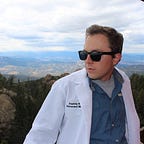A Third Path: We Don’t Have to Choose Between Killing the Economy and Killing the Elderly & Vulnerable.
The report from the imperial College of London recently caused a stir when it suggested: ”social distancing measures might have to be imposed for 18 months or more, at least intermittently, until a vaccine is developed and tested.” It also suggested that the virus might die down in the spring/summer and make a resurgence in the fall, much like the influenza pandemic of 1918. (1)
Pandemics, panic, and logical fallacies seem to go hand-in-hand.
One of those logical fallacies was promoted by the fact that people entirely ignored the phrase “at least intermittently“ and assumed the false dichotomy that we either need to kill the economy to save lives (strict social isolation for 18 months — no exceptions) or let the elderly and sick die (or sacrifice themselves, as Lt Gov Dan Patrick from Texas suggests) to save the economy.
To be clear, this is a *false* dichotomy. First, we are learning more about this virus and how it behaves day by day. Will we see it settle down when spring and summer come? Will be find some therapy that ends up being very effective?
If we consider these two possibilities as two separate ends of the spectrum, it is important to remember that there is a middle path, one that saves the economy AND lots of lives.
In the recent piece entitled “This is How We Beat the Coronavirus” Ashish Jha and Aaron Carroll, MD detail this third path forward in which we switch from “mitigation“ (or damage control) to “suppression“ (more proactive and aggressive control) (2). The main difference: testing. In China, South Korea, and other Asian countries their curves are flattening, or even decreasing, despite only being a few months into the pandemic because they are light years ahead of us in testing. They are not just testing the most sick, they are testing everyone. In testing everyone, or at least vastly more than we are currently testing, a public health system is able to identify positive cases early on, sometimes even before they show any symptoms, and encourage them to quarantine more strictly. They can also then perform aggressive contact tracing, reaching out every person they’ve contacted in the days before testing positive and testing them or encouraging them to self isolate for a few days.
Imagine the day that we ramped up our testing capabilities to the point that we could test everyone in the country every two weeks, or as soon as you developed symptoms? If we could do this, we could open up the economy nearly back to normal levels, confident that we had a robust system in place that will detect new local outbreaks early and aggressively isolate those who are positive.
Obviously, we are not to that point yet. In Utah, as in most other states, testing is so limited that we are still prioritizing very high-risk patients and those who are hospitalized. Additionally, as we are experiencing the “first wave“ of this illness, social distancing is especially important. However, after the first wave dies down, if we are able to ramp up our testing capabilities we will be able to revive our economy AND have sufficient safeguards to protect against a second wave of infections, buying time until an effective and safe vaccine can be developed and deployed worldwide.
Could this work? It worked in the small town in Italy where the first coronavirus fatality in their nation took place. How did they do it: they tested EVERYONE.
“Beginning on 6 March… we tested all residents of Vó, a town of 3,000 inhabitants near Venice — including those who did not have symptoms…The whole town was put into quarantine and every inhabitant was tested. The tests were processed by us at the University of Padua.”
“In the first round of testing, 89 people tested positive. In the second round [9 days later], the number had dropped to six, who remained in isolation. In this way, we managed to eradicate coronavirus from Vò, achieving a 100% recovery rate for those previously infected while recording no further cases of transmission… In this way, we eradicated coronavirus in under 14 days.” (3)
Yes, this is a small town, yes the demographic likely isn’t the same as ours, and yes they took extreme measures early on where several areas in the US are already well behind that, but the point is that it illustrates that widespread testing, under the right circumstances, can be extremely helpful in proactively suppressing this infection.
1 — Behind the Virus report that jarred the UK and US into action
2 — This Is How We Beat the Coronavirus — The Atlantic
3 — Scientists say mass tests in Italian town have halted Covid-19 there | World news | The Guardian
Update: a recent NYT piece about the various opinions on the economic costs of social isolation concluded with opinions from Paul M. Romer, who received the Nobel prize in economics in 2018, and Dr. Alan M. Garber, an economist and the provost of Harvard, who had a very similar view to what has been presented above:
“In the medium term, the tension between limiting the spread of the virus and restarting the economy will have to be resolved. For that to happen, the federal government must orchestrate and fund two initiatives:”
“The deployment of widespread weekly or even daily testing to allow the uninfected and the immune to ease social distancing.”
“A surge in the production of personal protective equipment, sufficient to cover 75 percent of the work force within four months, to prevent transmission of the virus.”
“With these interventions, people could return to work within a couple of months. Otherwise, they say, most Americans will survive the coronavirus, but the economy will die.”
https://www.nytimes.com/2020/03/24/opinion/coronavirus-economy-social-distancing.html?referringSource=articleShare
